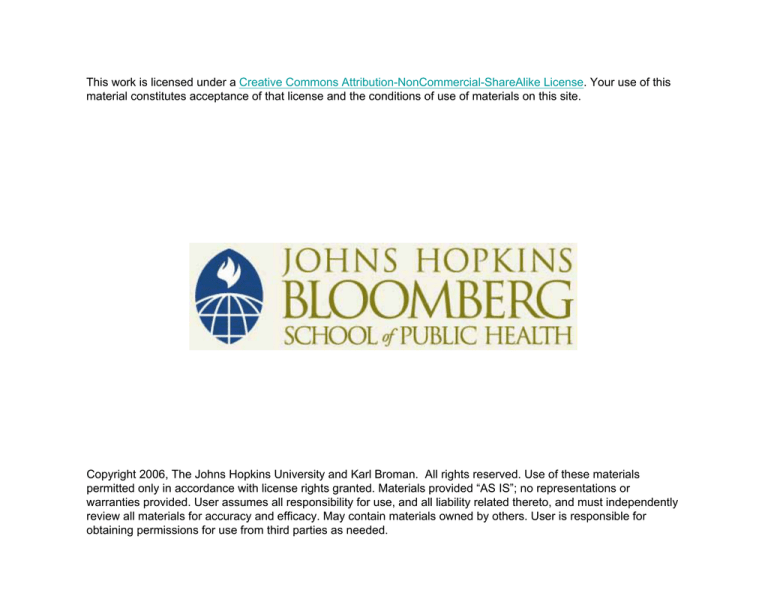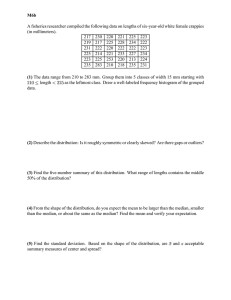
This work is licensed under a Creative Commons Attribution-NonCommercial-ShareAlike License. Your use of this
material constitutes acceptance of that license and the conditions of use of materials on this site.
Copyright 2006, The Johns Hopkins University and Karl Broman. All rights reserved. Use of these materials
permitted only in accordance with license rights granted. Materials provided “AS IS”; no representations or
warranties provided. User assumes all responsibility for use, and all liability related thereto, and must independently
review all materials for accuracy and efficacy. May contain materials owned by others. User is responsible for
obtaining permissions for use from third parties as needed.
How to display data badly
Karl W Broman
Department of Biostatistics
http://www.biostat.jhsph.edu/~kbroman
Using Microsoft Excel to
obscure your data and
annoy your readers
Karl W Broman
Department of Biostatistics
http://www.biostat.jhsph.edu/~kbroman
1
Inspiration
This lecture was inspired by
H Wainer (1984) How to display data badly.
American Statistician 38(2):137-147
Dr. Wainer was the first to elucidate the
principles of the bad display of data.
The now widespread use of Microsoft Excel has
resulted in remarkable advances in the field.
3
General principles
The aim of good data graphics:
Display data accurately and clearly.
Some rules for displaying data badly:
–
–
–
–
–
–
Display as little information as possible.
Obscure what you do show (with chart junk).
Use pseudo-3d and color gratuitously.
Make a pie chart (preferably in color and 3d).
Use a poorly chosen scale.
Ignore sig figs.
4
2
Example 1
5
Example 2
Distribution of genotypes
AA
AB
BB
missing
21%
48%
22%
9%
6
3
Example 3
7
Example 4
8
4
Example 5
9
Example 6
10
5
Example 7
11
Example 8
12
6
Displaying data well
• Be accurate and clear.
• Let the data speak.
– Show as much information as possible, taking
care not to obscure the message.
• Science not sales.
– Avoid unnecessary frills — esp. gratuitous 3d.
• In tables, every digit should be meaningful.
Don’t drop ending 0’s.
13
Further reading
• ER Tufte (1983) The visual display of quantitative
information. Graphics Press.
• ER Tufte (1990) Envisioning information. Graphics
Press.
• ER Tufte (1997) Visual explanations. Graphics
Press.
• WS Cleveland (1993) Visualizing data. Hobart Press.
• WS Cleveland (1994) The elements of graphing data.
CRC Press.
14
7
Displaying distributions
Dotplots
• Few
data points per
group
25
• Possibly
20
15
A
B
Group
many groups
Histograms
Symmetric distribution
• Many
data points per
group
• Few groups
5
10
15
20
25
30
Skewed distribution
0
10
20
30
40
35
• Area
of rectangle prop. to
number of data points in
interval
• I like many bins
√
(typically 2 n)
50
Boxplots
• Many
70
data points
• Possibly
many groups
• Displays minimum, lower
quartile, median, upper
quartile and maximum
60
50
40
30
20
A
B
C
Group
D
Summary statistics
Location/
Center
mean (i.e., average)
median
mode
geometric mean
harmonic mean
Scale
standard deviation (SD)
inter-quartile range (IQR)
range
Other
quantile
quartile
quintile
The means
mean
n
1 X
=
xi = (x1 + x2 + . . . + xn)/n
n
i=1
geometric mean
v
un
n
X
uY
1
n
xi = exp
log xi
= t
n
i=1
harmonic mean = 1/
i=1
n
1 X
n
i=1
(1/xi)
Measures of location/center
• Forget
about the mode.
• The mean is sensitive to outliers.
(The balance point for the histogram.)
• The median is resistant to outliers.
• The
geometric mean is used when a logarithmic
transformation is appropriate (for example, when
the distribution has a long right tail).
• The
harmonic mean may be used when a reciprocal transformation is appropriate (very seldom).
Symmetric data
80
90
100
HM
GM
Mean
Median
70
110
120
130
Skewed data
10
20
30
40
50
HM
Median
GM
Mean
0
A key point
The different possible measures of the “center” of the
distribution are all allowable.
• Which
is the best measure of the “typical” value
(for your situation)?
• Be sure to make clear which “average” you use.
Standard deviation (SD)
sample variance
n
1 X
(xi − x̄)2 = s2
=
n−1
i=1
sample SD
=
=
=
=
√
s2 = s
RMS (distance from average)
“typical” distance from the average
sort of like ave{|xi − x̄|}
n
Note:
1X
xi
x̄ =
n
i=1
Symmetric data
SD
80
90
100
GM
Mean
Median
70
110
120
130
Skewed data
SD
10
Median
GM
Mean
0
20
30
40










